
No matter when you start, it is important that you do not stop after starting. No matter when you end, it is more important that you do not regret after ended.
Tuesday, June 30, 2009
Mirabelle's First "Hike" ..
So last Thursday we were running some errands in Shoreline and decided to stop by Shoreview Park as it was not raining and we needed something to do that was not our errands. Jennifer and I had stopped by there previously, but I think we were on bicycles and it was our turnaround point for a ride, complete with bathrooms. We only knew of the ball fields and were not fully aware of the wooded paths at the park. Heading there last Thursday, I presumed there must be some type of wooded trail system.
When we arrived last week we poked around a bit before discovering the map of the trails. We headed in for a walk. It turns out, for a city park, Shoreview/Boeing Creek Park has fairly rugged trails. Muddy eroded off camber trails provided us with some interesting footing as we headed down to the creek. Jennifer was fortunate enough to be wearing running shoes with some tread, while I was slip sliding around in my treadless Sanuks. There was a "wet" creek crossing that I had to help Jennifer navigate as she was toting around our precious cargo.
Some of the trees in the park were of good size too. (With signs telling you just how big they are.) Plenty of 200'+ Douglas Firs in the park with sizable trunks. We walked all the way down to Hidden Lake, and then back up to the dog run before eventually returning to the car. I recommend to anyone in the north end of Seattle to take a short trip up to Shoreview if they are looking to get away from their typical walks in Carkeek and Golden Gardens. Just be prepared to get your feet wet.

When we arrived last week we poked around a bit before discovering the map of the trails. We headed in for a walk. It turns out, for a city park, Shoreview/Boeing Creek Park has fairly rugged trails. Muddy eroded off camber trails provided us with some interesting footing as we headed down to the creek. Jennifer was fortunate enough to be wearing running shoes with some tread, while I was slip sliding around in my treadless Sanuks. There was a "wet" creek crossing that I had to help Jennifer navigate as she was toting around our precious cargo.
Some of the trees in the park were of good size too. (With signs telling you just how big they are.) Plenty of 200'+ Douglas Firs in the park with sizable trunks. We walked all the way down to Hidden Lake, and then back up to the dog run before eventually returning to the car. I recommend to anyone in the north end of Seattle to take a short trip up to Shoreview if they are looking to get away from their typical walks in Carkeek and Golden Gardens. Just be prepared to get your feet wet.

Sunday, June 28, 2009
Closure Systems on Bicycle Bags
 |
| Cristobal Pannier |
Having now owned and tried a number of bicycle bags, one of the features I pay close attention to is the closure - particularly on bags I use every day. Many classic bicycle bags are fitted with traditional buckles. While I love the idea of it, in practice I find that I fiddle with the closure way too much every time I want to open or close the bag.
 |
| Carradice Kendal Pannier |
And with bags that use really thin straps, there is the additional issue of the straps fraying and breaking off from frequent use.
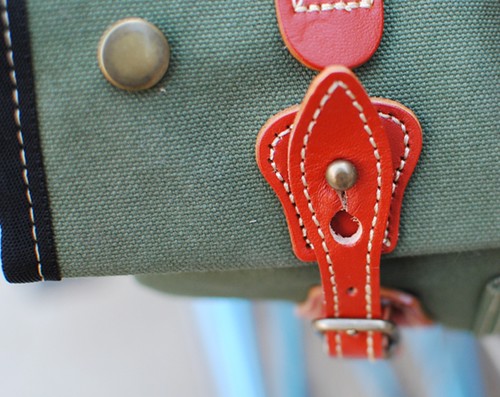 |
| Zimbale 7L Saddlebag |
Zimbale bags use a quick "Sam Browne" style closure that does not require undoing the buckle. This is the biggest reason I favour my Zimbale over my near-identical Carradice; it simply takes me less time to open and close the bag. I've had this bag for 2 years now, and over time there has been some stretching in the leather eyelets, but not so much that the closure comes undone.
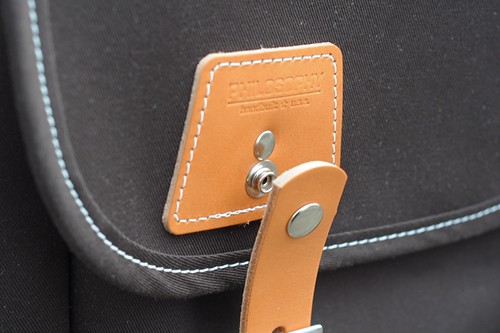 |
| Philosophy Pannier |
Philosophy bags use a snap closure, also independent of the buckle. It works well and does not seem to stress the leather. I sometimes worry about the security, but it has not come undone as of yet.
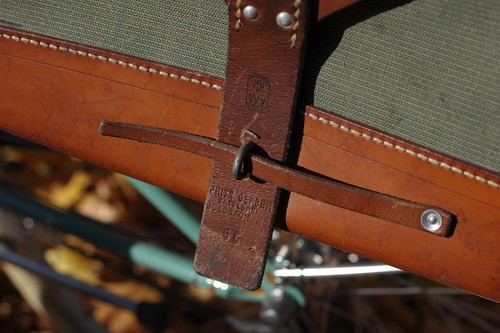 |
| OYB Pannier |
Some vintage Swiss Army bags feature an interesting "latch" system where a stiff cord is inserted into a metal loop. It is simple and secure, though the cord may need to be replaced after some use.
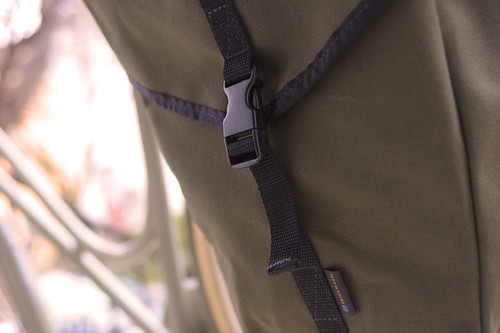 |
Ironweed Pannier(more pictures and review soon) |
Nylon cords with plastic buckle closures seem pretty easy and convenient, but it's a system I haven't used until just now.
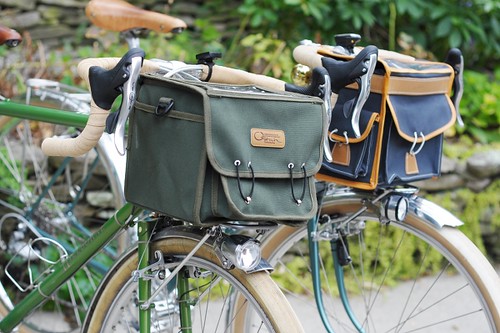 |
| Ostrich Handlebar Bag & Berthoud Medium Handlebar Bag |
I love the simplicity of elastic closures. But in my experience, it's not always easy to get the tension of the elastics just right, and I've been in situations where various parts of my handlebar bag have flung open en route. The elastics also tend to stretch out over time, so they may need to be tightened or replaced after some use.
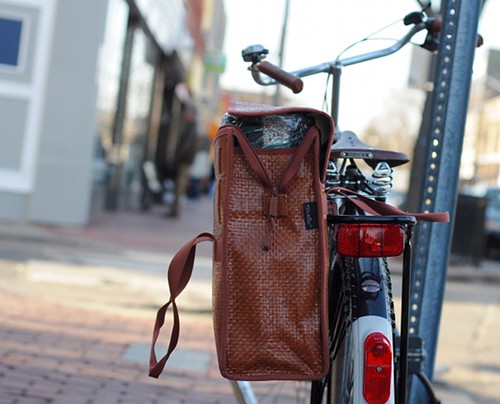 |
| Fastrider Deluxe Shopper Pannier |
Zipper and velcro closures work nicely - except when the bag is full and cannot close completely.
 |
| Po Campo Loop Pannier |
All closure systems seem to have their pros and cons - from ease of use, to security, to durability. Overall I tend to favour the quick and easy methods, though I do wish I had the patience and digital dexterity for tiny buckles.
What closure system do you prefer on bicycle bags?
Wednesday, June 24, 2009
Making Sense of Handling Characteristics
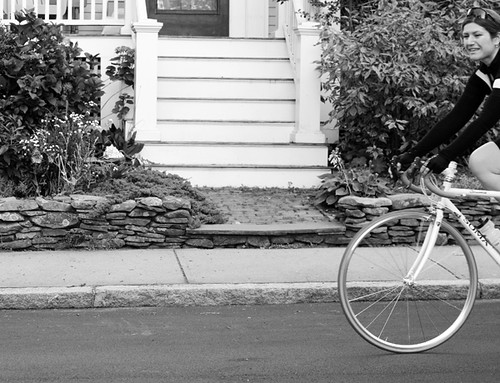
"Hey, so how does it ride?"
It seems like such a simple question. But the more I learn about bikes, the less certain I am how to answer it.As cyclists, our experience expands as we ride more, and as we try different bikes. And our vocabulary expands as we talk to other cyclists, bike mechanics, salespersons; as we read cycling literature, including myriads of bicycle reviews in magazines and blogs.One thing I notice is that while there are default terms used to describe bicycle handling characteristics, these terms are weakly defined - with different persons using them in different contexts.In particular, it fascinates me to navigate descriptions of bicycle stability versus twitchiness.
In reviews I will often read that a stable bicycle "tracks well" or "rides like it's on rails."As I understand this notion, it means that the bike holds its line of travel on its own accord, without the rider having to constantly micro-correct the steering. This is generally considered to be a good thing. But can it be too good? For me, when experienced at high speeds the feeling of the bike being on rails can also make it resistant to turning. And what about going around sudden obstacles? If the bike tracks so well that it resists changing course, would this not present a problem when encountering an unexpected pothole, or when the rider in front of us swerves?
The concept of twitchiness is not so simple either. There seem to be different kinds, and I can think of at least three: There is the "squirrely" twitchiness of a racing bike that makes it hard to controlat slow speeds.This is not to be confused with the twitchiness of low trail - a very different kind of feeling, that gives the rider a more active role in the bicycle's line of travel. There is also the twitchiness associated with a "light front end," regardless of geometry.
Stability can vary with speed. On some bikes there seems to be a linear relationship: The bike will start out twitchy when slow, stabilise at moderate speeds, and "ride like it's on rails" when going especially fast. The faster you go, the more stable it is. Other bikes will be stable at slow speeds and track exceptionally well at moderate speeds, but then level out or even ease up at fast speeds. Other bikes still will handle more or less the same regardless of how fast you ride them.
Whether a bike is described as stable or twitchy, it is hard to know what that means without additional detail, which is not always available. What I wonder is, have there been efforts to maybe create a guideline for both reading and providing descriptions of how a bicycle rides? Without context and well defined terminology, it seems that anything goes and we can easily misunderstand each other's impressions of handling characteristics.
Monday, June 22, 2009
But now they only block the sun...
Sunday morning (August 15th) I woke up early and was just lying in my cot looking out the window when I noticed the sky getting brighter. Then when I looked toward the eastern sky it was filled with a beautiful pink and orange glow. I quickly changed clothes, grabbed the camera and walked to Land's End on the tip of the Homer Spit.
 6:09 am
6:09 am
 6:12 am
6:12 am
 6:18 am
6:18 am
 6:20 am
6:20 am
 6:22 am
6:22 am
 6:40 am
6:40 am
The colors began to fade as the sun started to make its appearance. I say “started” because the lower bank of clouds/fog quickly grew and the sun was hidden for yet another day.
I've cropped off the bottom portion of all photos except for one because that part didn't really add anything to the beauty and simplicity of the clouds and the colors.
The title of this post comes from the song Both Sides Now by Joni Mitchell.
 6:09 am
6:09 am 6:12 am
6:12 am 6:18 am
6:18 am 6:20 am
6:20 am 6:22 am
6:22 am 6:40 am
6:40 amThe colors began to fade as the sun started to make its appearance. I say “started” because the lower bank of clouds/fog quickly grew and the sun was hidden for yet another day.
I've cropped off the bottom portion of all photos except for one because that part didn't really add anything to the beauty and simplicity of the clouds and the colors.
The title of this post comes from the song Both Sides Now by Joni Mitchell.
Saturday, June 20, 2009
The Closest Thing to a Valentine
In all of the photo albums and family papers of my grandmother's, I haven't come across any valentines or love letters written by or to anyone. None. Zilch. Nada. And I don't have any personal valentines (that I'd care to share). So with my birthday being just 3 days after Valentines Day, I thought these cards might be good substitutes for inclusion in the 20th edition of Smile For The Camera. My niece Carrie made them a “few” years ago (when she was 9 or 10 years old). The images were previously published here on kinexxions in July ...




Wednesday, June 17, 2009
Sunset Arch

When we were done hiking Coyote Gulch we headed for our next planned adventure of the day, which was a sunset hike to Sunset Arch! We had read about and seen photos of Sunset Arch in the guide book that we had and knew it was something we didn't want to miss. The hike was described as easy but without any marked trail so we were hoping this would mean we might have it to ourselves. Sure enough, we did! We ended up not see a single other soul in our time to and fromthe arch. It was wonderful!
As we left the Dry Fork of Coyote Gulch trailhead we turned left and continued down Hole in the Rock road until we reached 40 Mile Ridge Road, then we followed this road about 4 miles to a marked trailhead on the left. This trailhead was for a different hike, and our book recommended hiking from there to Sunset Arch, which was in the opposite direction from the trailhead. We instead opted to backtrack along 40 Mile Ridge Road to a spot we had seen on the way in that looked like it would make a good campsite (you can camp pretty much anywhere as long as it is an area that has already been disturbed by humans). We found our spot and it was indeed a terrific place to camp. After setting up our camp and relaxing for a few minutes we got our gear ready, plugged the coordinates for the arch into our GPS unit (the coordinates were provided in our guide book), and off we went across the open desert right from our campsite.

We couldn't see the arch from our campsite, but we knew which way to go thanks to the GPS. After walking about 3/4 of a mile across the desert we got our first glimpse of the arch, still over a quarter of a mile away. It was fascinating to see from a distance, and we wondered just how big it would be once we got up close to it. We kept walking towards the arch and reached the base of it a few minutes later, 1.15 miles from our campsite. Indeed, it was much bigger than we thought it would be when viewing it from a quarter mile away! The arch was mind-boggling, just standing there all by itself surrounded by nothing but relatively flat desert. We spent about an hour admiring and photographing the arch, then just after sunset we headed back to our campsite, arriving just as it was starting to get really dark. Jessica prepared a delicious meal over the camp stove then we washed up and crawled into the tent to get some much-needed rest before the next adventure which awaited us the following morning: Willow Gulch and Broken Bow Arch!
Saturday, June 13, 2009
Redbud at Night
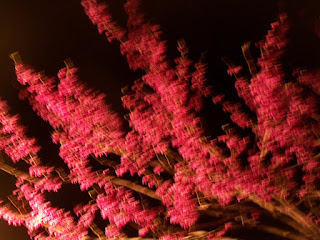


I took the dogs out about 2 am the other night and noticed that the light that had been moved recently was shining on the blossoms of the redbud. I got the camera and tried a couple of shots. Had to work with it a bit to get the right setting but thought that the effect on all 3 photos was at least different.
Sunday, June 7, 2009
How Upright Is Upright?

There is a tendency to group all upright transportation bicycles into the same general townie/cruiser-ish category. And when we see the description "upright bike" we imagine whatever it is that fits our own definition of that idea. But differences in what are commonly referred to as "upright" positions can be considerable. Above are three classic examples side by side: a traditional Dutch bike, an Italian city bike, and a French-style mixte - all three of which I have owned and ridden.
To a large extent it is the placement of the handlebars that determines how upright a bicycle is set up. But while the Dutch bike's handlebars can be lowered and the bars on the other two can be raised, it's not entirely as simple as that: The design of the frame itself assumes a particular range of positions; the frame geometry is optimised for it.
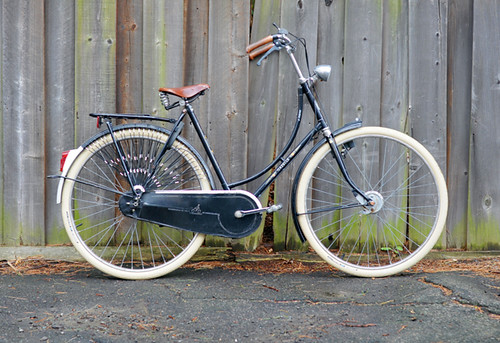
The Dutch bike is designed to enable a bolt-uright posture. The handlebars are high. The stem is so short as to be practically non-existant, bringing the bars even closer to the rider's body. The seat tube angle is slack. Altogether, the cyclist is "pushed back" on the bike into what almost resembles an armchair position. The epitome of "upright," this posture is not for everyone. But it is supremely comfortable for short trips and it allows cyclist to observe their surroundings from a greater height.
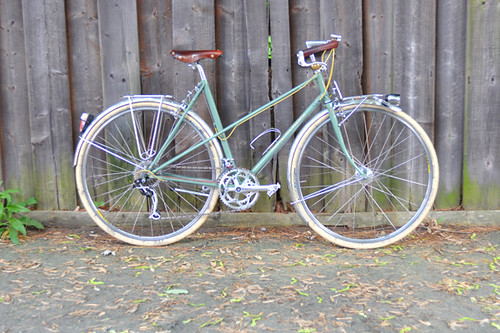
The traditional French mixte is typically more aggressive than other city bikes. The frame design is frequently not very different from that of a road bike - steep angles, head tube not much higher, if at all, that the seat tube, comparatively lightweight tubing. When built up as upright bikes, these bicycles are at their best when set up with long stems and handlebars at or even below saddle level. With the cyclist's weight pushed forward, the bicycle is extremely responsive and maneuverable. But the "upright" posture with this set-up can be quite aggressively leaned over.
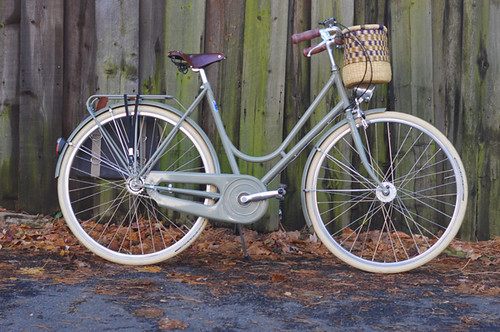
Somewhere in the middle, the Italian city bike is really a variation of the so-called "sports roadster"design(the ubiquitous Raleigh Sports and Lady's Sports were examples of these): swept-back handlebars at or moderately above saddle level, combined with a short stem for a generally upright but slightly leaned-forward position. The seat tube is not as slack as that on a Dutch bike, but still relatively relaxed. The cyclist can lean into the bike if they wish to apply more power, or they can sit back. I personally find this to be a very versatile position - though others might call it "neither/ nor" - neither as regally relaxed as a Dutch bike, nor as maneuverable as a roadish French mixte.
While definitions of "upright bike" run the gamut, my personal definition requires that the bicycle pass the Camera Test. That is, I must be able to ride the bike with my large camera staying put on my back, strap worn across my chest, without the camera rotating to the front. I can't do it on a roadbike with drop bars, not even when I am on the hoods or the tops. But I can do it on all three bikes shown in this post, which makes them all different variations of "upright" to me. What do you typically think of as an upright position, and which do you prefer for everyday cycling?
Saturday, June 6, 2009
Touchy-Feely
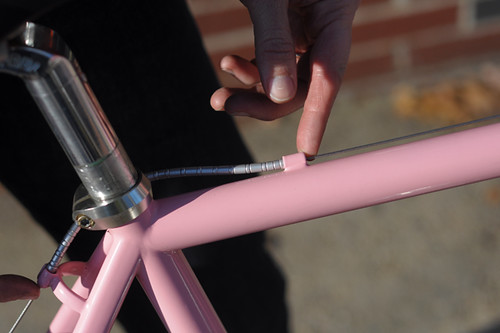
I have a funny habit of touching bicycles. It starts innocently enough: First a glance, then a closer look, then a quick stroke or two. But before I know it I am engaged in an orgy of tactile exploration that has been known to shock by-standers. Slowly and affectionately I will run my hand over the frame, tracing the outlines of the lugwork, closely examining the joints, touching the braze-ons one by one, visibly savouring every moment of it. Those who know me in person tease me about this, and apparently even discuss it behind my back good-naturedly. At Interbike last year, I was giving a bike a furtive fondle when the manufacturer snuck up behind me, laughing: "They toldme you were going to do this!"
When it comes to other people's bikes, I do ask permission - much as I would ask for permission to pet someone's dog or cat. "May I?" My voice andmy outstretched handtremble with anticipation. The owner is amused and delighted, if somewhat taken aback by the intensity of my interest.
But though my case may be extreme, I am hardly alone in the bike-fondling affliction. Even without asking, strangers will often stroke my bikes absent-mindedly - their hands drawn to a leather saddle, a headbadge, some shellacked twine, lugwork. "This part here..." an acquaintance suddenly said mid-conversation, pointing to the top of my bike's fork. "It's so... cake-like! What is it for?" Excitedly I began to explain about fork crowns, but stopped myself as the poor person's eyes glazed over. They didn't want to know. But they did want to touch.
I think that bicycles - particularly bicycles with all sorts of interesting or organic-looking bits on them - tend to invite tactile attention. Say what you will about looks mattering or not mattering, but when a bicycle draws us in physically, surely that is a good thing.
Are you touchy-feely when it comes to bikes? Do others tend to touch your bike, and do you mind?
Friday, June 5, 2009
Lake Itasca :: Headwaters of the Mississippi
Monday, August 8th - - About 9:15 pm a Park Ranger drove through the campground at Copper Falls announcing over the loudspeaker that the National Weather Service had issued a severe storm warning effective until ten o'clock. High winds, hail, heavy rain and lightening were imminent. All campers were to take immediate shelter!
I saw people scurrying around their tents putting things away and heading towards their cars or trucks. Me? I was already sitting in Van Dora. Snug as a bug in a rug. I didn't see anyone leaving the area so I stayed put. Besides, where were we to go?
Within a few minutes after making the announcement, the rain came. Aside from a lot of lightening there was only the rain. No hail. No high winds. And it only lasted about an hour. And for that I was thankful. My thoughts went to that campground in Arkansas last year where flash floods went through the area and several people lost their lives. We had some warning, and I was ready to leave, if necessary. But the question came once again, where would we go?
Tuesday, August 9th - - It was cloudy and overcast this morning. It rained off and on all morning. I was traveling west on US 2 toward Minnesota. At Ashland, Wisconsin I picked up State Road 13 and followed it along the beautiful Lake Superior shoreline all the way to Superior-Duluth where I returned to US 2. By then the weather had cleared. The clouds were gone (mostly) and sunshine filled the skies as I traveled nearly three-fourths of the way across Minnesota. I would spend several days at Itasca State Park south of Bemidji.
Wednesday, August 10th - - Itasca is a huge State Park with a lodge, cabins, two campgrounds with more than 250 sites, more than 40 miles of hiking trails, a 5.8 mile paved biking trail, and numerous lakes within its 32,000 acres. The Park was established in 1891 to preserve remnant stands of virgin pine and to protect the basin around the source of the Mississippi River.

This little stream doesn't look like much, does it? However, it is the Mississippi River, flowing rather quickly just a few hundred feet from its source at the north end of Lake Itasca.

This sign proclaims “Here 1475 ft above the ocean the mighty Mississippi begins to flow on its winding way 2552 miles to the Gulf of Mexico.” My Mother and I visited New Orleans in the summer of .. and saw where the Mississippi flowed into the delta and into the Gulf. Like US Highway 41, I've traveled along portions of the Mississippi and now I've not only been at its end, I've seen its beginning. Rather cool, I think.

This is it. The headwaters of the Mississippi River. People are encouraged to “walk across the Mississippi” here, one of the few places accessible for the average person to do so.

The rocks were quite slippery. This man and his son nearly toppled into the water several times. I didn't attempt to walk across the rocks but there was a narrow log footbridge - perhaps 18 inches wide, so maybe not so narrow, but it seemed so when walking across it without handrails for assistance!
I walked a ways down the trail along the shore of the lake but little could be seen because of the trees. There were some interesting wild flowers though!



And this small, fluffy, milkweed type of plant.
I saw people scurrying around their tents putting things away and heading towards their cars or trucks. Me? I was already sitting in Van Dora. Snug as a bug in a rug. I didn't see anyone leaving the area so I stayed put. Besides, where were we to go?
Within a few minutes after making the announcement, the rain came. Aside from a lot of lightening there was only the rain. No hail. No high winds. And it only lasted about an hour. And for that I was thankful. My thoughts went to that campground in Arkansas last year where flash floods went through the area and several people lost their lives. We had some warning, and I was ready to leave, if necessary. But the question came once again, where would we go?
Tuesday, August 9th - - It was cloudy and overcast this morning. It rained off and on all morning. I was traveling west on US 2 toward Minnesota. At Ashland, Wisconsin I picked up State Road 13 and followed it along the beautiful Lake Superior shoreline all the way to Superior-Duluth where I returned to US 2. By then the weather had cleared. The clouds were gone (mostly) and sunshine filled the skies as I traveled nearly three-fourths of the way across Minnesota. I would spend several days at Itasca State Park south of Bemidji.
Wednesday, August 10th - - Itasca is a huge State Park with a lodge, cabins, two campgrounds with more than 250 sites, more than 40 miles of hiking trails, a 5.8 mile paved biking trail, and numerous lakes within its 32,000 acres. The Park was established in 1891 to preserve remnant stands of virgin pine and to protect the basin around the source of the Mississippi River.

This little stream doesn't look like much, does it? However, it is the Mississippi River, flowing rather quickly just a few hundred feet from its source at the north end of Lake Itasca.

This sign proclaims “Here 1475 ft above the ocean the mighty Mississippi begins to flow on its winding way 2552 miles to the Gulf of Mexico.” My Mother and I visited New Orleans in the summer of .. and saw where the Mississippi flowed into the delta and into the Gulf. Like US Highway 41, I've traveled along portions of the Mississippi and now I've not only been at its end, I've seen its beginning. Rather cool, I think.

This is it. The headwaters of the Mississippi River. People are encouraged to “walk across the Mississippi” here, one of the few places accessible for the average person to do so.

The rocks were quite slippery. This man and his son nearly toppled into the water several times. I didn't attempt to walk across the rocks but there was a narrow log footbridge - perhaps 18 inches wide, so maybe not so narrow, but it seemed so when walking across it without handrails for assistance!
I walked a ways down the trail along the shore of the lake but little could be seen because of the trees. There were some interesting wild flowers though!



And this small, fluffy, milkweed type of plant.
Thursday, June 4, 2009
Tin Tray
 This was a tin tray that belonged to my mom before she met my dad. It has tulips in the design and the handle had other flowers on it. It says it is made by Rodney Kent. Apparently he made a lot of beaten tin items back in the 1920' and 30's. I also have a round plate by him with no design. I found lots of his work on the internet.
This was a tin tray that belonged to my mom before she met my dad. It has tulips in the design and the handle had other flowers on it. It says it is made by Rodney Kent. Apparently he made a lot of beaten tin items back in the 1920' and 30's. I also have a round plate by him with no design. I found lots of his work on the internet.Lovely summer day on Lucille Island

Today Lake Superior displayed an incredibly calm mood that is rarely seen. I couldn't pass up the opportunity the lake was presenting, so I headed out in my boat and spent the day photographing and exploring the islands that are near my home. In the afternoon some really nice clouds started to show up. Adding a polarizer filter to my lens really helped to accent the clouds as well as cut the glare from the water, so the shallow rocks and reefs could really show up in the images. It was an incredible day to be on the water!
5-Speed Conversion!
My conversion of the Mercier mixte to a 5-speed is pretty much complete, and it worked out nicely. I've received some questions about the process since I first mentioned my plan to do this, so I include answers to these questions here.
 What is a 5-Speed Conversion?
What is a 5-Speed Conversion?
A 5-speed conversion refers to transforming a vintage 10-speed bicycle into a 5-speed by removing one of the two front chainrings and the front derailleur system (see before and after pictures above). In the end, the bicycle is left with a much simpler set-up of 5 chainrings in the rear, 1 chainring in the front, and a single gear shifter. It works much the same as a 5-speed hub, only the gears are visible rather than hidden inside the hub.
 Why do this? Doesn't it mean you have fewer speeds now?
Why do this? Doesn't it mean you have fewer speeds now?
Hard question to answer, but I will try: The advantage of a derailleur over an internal hub, is that it allows for much wider spaced gearing. Riding the Mercier around hilly areas, I can get by perfectly well with just the middle 3 rear gears. The 2 extra rear chainrings provide a nice "just in case" buffer of one higher and one lower gear than I'd ever need, but the second front ring (which provides 5 additional speeds) and the whole front derailleur system (which switches between the two front rings) are useless entirely in the context of where and how I plan to ride this bike. Given my certainty of this, converting it to a 5-speed made sense, because it would simplify the handling of the bicycle and it would get rid of extraneous components. Also, this bike (as many older French bicycles) was originally designed to have a rear-only derailleur system. This is evident, because it has a braze-on (on the downtube) for just a single gear shifter. So converting it to a 5-speed reverts to a traditional design.
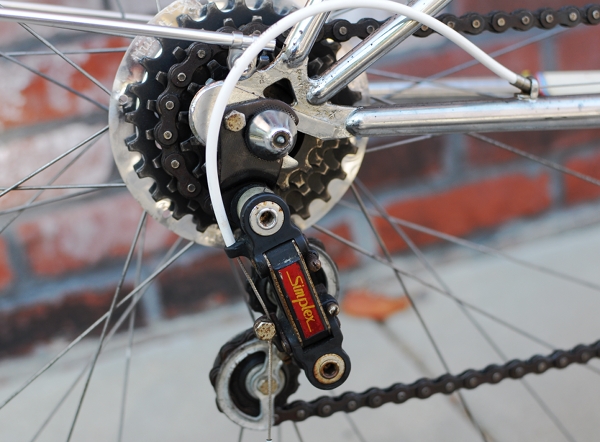 If you're going to make it a 5-speed, why not use a 5-speed hub and ditch the derailleur system all together?
If you're going to make it a 5-speed, why not use a 5-speed hub and ditch the derailleur system all together?
The main reason, is that no existing 5-speed hub could give me the same customised, wide spacing as a 5-speed rear derailleur. It's not just about how many speeds you have, but how useful each of those speeds are. Additionally, it would cost a ton of money to rebuild the rear wheel with a 5-speed hub, whereas the 5-speed derailleur conversion was inexpensive. And finally, I am trying to keep this bicycle fitted with traditional components, and French bicycles were traditionally fitted with derailleurs.
How was the conversion done?
Keeping in mind that the process will differ depending on your current set-up, here is what generally needs to be done, step-by-step:
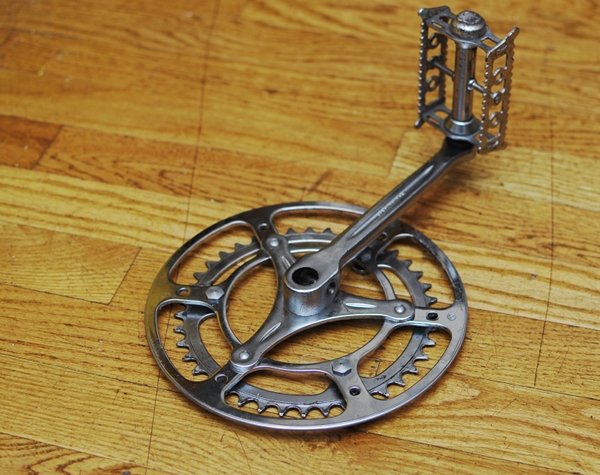 1. Front chainring removal
1. Front chainring removal
Since you will only have one chainring in the front now, you need to figure out how to get rid of the second one. The main issue here has to do with how the crank arm is attached to the ring(s). On some bicycles, it is possible to simply remove the extraneous chainring and the remaining chainring will hold up the crank. On my Mercier, the two rings are a unit, attached to the crank via a proprietary bolt system. To make a long story short, we could not simply remove the extra ring. Rather than get an entire new chainring and crank system, it occured to me that perhaps the teeth on the bigger chainring could be filed off - turning the ring into a chainguard. I discussed the idea with metalworker and bicycle mechanic Jon Gehman, who is a reader of this blog, and he agreed that this was a good way to go. I then sent him the chainring for a "de-toothing" service, and he did a spectacular job.
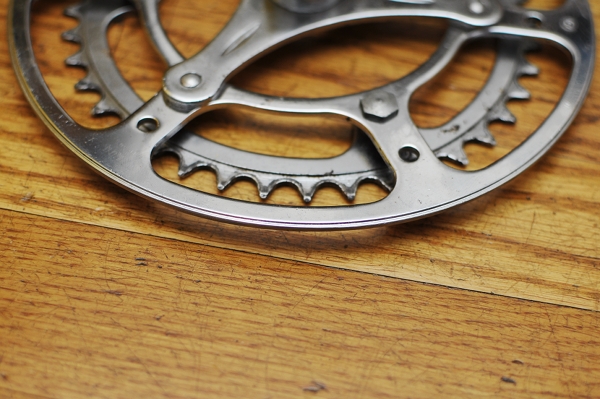 Here is a close-up of what was formerly the larger chainring. Notice how beautifully the edge is done - giving it a professionally finished look.
Here is a close-up of what was formerly the larger chainring. Notice how beautifully the edge is done - giving it a professionally finished look.
 2. Front derailleur removal
2. Front derailleur removal
This was the easiest part. The Simplex front derailleur simply unbolts and removes. On the picture above you can see that the rainbow decal is a little worn where it used to be, but that is all.
 3. Changing the shifters
3. Changing the shifters
The ease or difficulty of this step depends entirely on what sort of shifters you have to begin with. If your bicycle has separate (unconnected) shifters for the rear and front derailleurs, then you simply remove the one that controls the front and you are done. If your shifters are a unit, then you will have to remove them and install a single shifter instead. Above is a vintage Huret single shifter for mounting on the stem that I bought for this purpose. It's beautiful, "period-correct", and can be bought fairly inexpensively. The Co-Habitant installed the shifter and connected the cable to the derailleur.
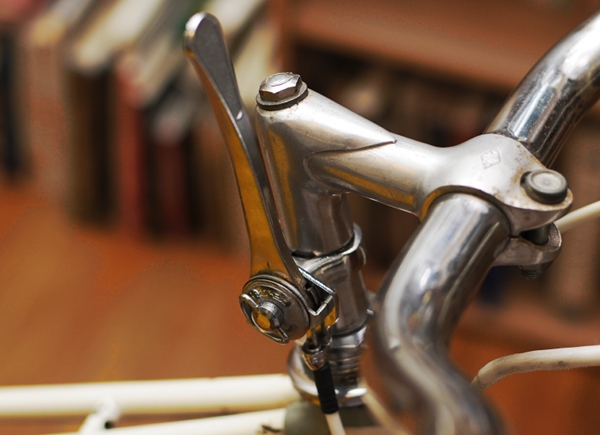 Here is the Huret shifter installed on the stem. I am not 100% sure though that this is the ultimate solution. Originally, the Mercier had downtube shifters, and this is where the single braze-on is located. However, I do not understand how one is supposed to use downtube shifters on a near-upright bicycle. At least for me, and in traffic, they were too much to handle - especially given that the shifting has to be done with the right hand.
Here is the Huret shifter installed on the stem. I am not 100% sure though that this is the ultimate solution. Originally, the Mercier had downtube shifters, and this is where the single braze-on is located. However, I do not understand how one is supposed to use downtube shifters on a near-upright bicycle. At least for me, and in traffic, they were too much to handle - especially given that the shifting has to be done with the right hand.
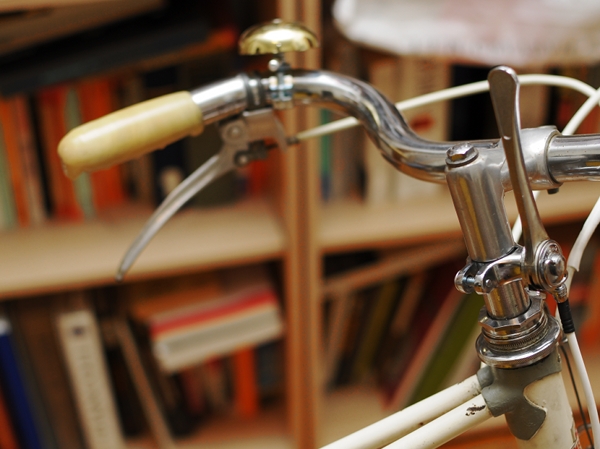 So now there is a cable stopper where the downtube braze-on is, and the cable then extends further to the stem. Though the Huret shifter is beautiful on its own, I am not sure how fitting it is here. For instance, the reason it is not all the way at the bottom of the stem, is that placing it here makes it hit the handlebar when it is moved all the way forward. Hmm, right? Your thoughts on this welcome.
So now there is a cable stopper where the downtube braze-on is, and the cable then extends further to the stem. Though the Huret shifter is beautiful on its own, I am not sure how fitting it is here. For instance, the reason it is not all the way at the bottom of the stem, is that placing it here makes it hit the handlebar when it is moved all the way forward. Hmm, right? Your thoughts on this welcome.
Overall I am thrilled with the 5-speed conversion. The Mercier is light, easier than ever to handle, and now ready for its fate as Studio Bike. I admit that I am reluctant to send it over to the Studio and quite like having it here at home. But I also look forward to exploring a new neighborhood together... and to having less bike clutter in our apartment!
 What is a 5-Speed Conversion?
What is a 5-Speed Conversion?A 5-speed conversion refers to transforming a vintage 10-speed bicycle into a 5-speed by removing one of the two front chainrings and the front derailleur system (see before and after pictures above). In the end, the bicycle is left with a much simpler set-up of 5 chainrings in the rear, 1 chainring in the front, and a single gear shifter. It works much the same as a 5-speed hub, only the gears are visible rather than hidden inside the hub.
 Why do this? Doesn't it mean you have fewer speeds now?
Why do this? Doesn't it mean you have fewer speeds now? Hard question to answer, but I will try: The advantage of a derailleur over an internal hub, is that it allows for much wider spaced gearing. Riding the Mercier around hilly areas, I can get by perfectly well with just the middle 3 rear gears. The 2 extra rear chainrings provide a nice "just in case" buffer of one higher and one lower gear than I'd ever need, but the second front ring (which provides 5 additional speeds) and the whole front derailleur system (which switches between the two front rings) are useless entirely in the context of where and how I plan to ride this bike. Given my certainty of this, converting it to a 5-speed made sense, because it would simplify the handling of the bicycle and it would get rid of extraneous components. Also, this bike (as many older French bicycles) was originally designed to have a rear-only derailleur system. This is evident, because it has a braze-on (on the downtube) for just a single gear shifter. So converting it to a 5-speed reverts to a traditional design.
 If you're going to make it a 5-speed, why not use a 5-speed hub and ditch the derailleur system all together?
If you're going to make it a 5-speed, why not use a 5-speed hub and ditch the derailleur system all together? The main reason, is that no existing 5-speed hub could give me the same customised, wide spacing as a 5-speed rear derailleur. It's not just about how many speeds you have, but how useful each of those speeds are. Additionally, it would cost a ton of money to rebuild the rear wheel with a 5-speed hub, whereas the 5-speed derailleur conversion was inexpensive. And finally, I am trying to keep this bicycle fitted with traditional components, and French bicycles were traditionally fitted with derailleurs.
How was the conversion done?
Keeping in mind that the process will differ depending on your current set-up, here is what generally needs to be done, step-by-step:
 1. Front chainring removal
1. Front chainring removalSince you will only have one chainring in the front now, you need to figure out how to get rid of the second one. The main issue here has to do with how the crank arm is attached to the ring(s). On some bicycles, it is possible to simply remove the extraneous chainring and the remaining chainring will hold up the crank. On my Mercier, the two rings are a unit, attached to the crank via a proprietary bolt system. To make a long story short, we could not simply remove the extra ring. Rather than get an entire new chainring and crank system, it occured to me that perhaps the teeth on the bigger chainring could be filed off - turning the ring into a chainguard. I discussed the idea with metalworker and bicycle mechanic Jon Gehman, who is a reader of this blog, and he agreed that this was a good way to go. I then sent him the chainring for a "de-toothing" service, and he did a spectacular job.
 Here is a close-up of what was formerly the larger chainring. Notice how beautifully the edge is done - giving it a professionally finished look.
Here is a close-up of what was formerly the larger chainring. Notice how beautifully the edge is done - giving it a professionally finished look. 2. Front derailleur removal
2. Front derailleur removalThis was the easiest part. The Simplex front derailleur simply unbolts and removes. On the picture above you can see that the rainbow decal is a little worn where it used to be, but that is all.
 3. Changing the shifters
3. Changing the shiftersThe ease or difficulty of this step depends entirely on what sort of shifters you have to begin with. If your bicycle has separate (unconnected) shifters for the rear and front derailleurs, then you simply remove the one that controls the front and you are done. If your shifters are a unit, then you will have to remove them and install a single shifter instead. Above is a vintage Huret single shifter for mounting on the stem that I bought for this purpose. It's beautiful, "period-correct", and can be bought fairly inexpensively. The Co-Habitant installed the shifter and connected the cable to the derailleur.
 Here is the Huret shifter installed on the stem. I am not 100% sure though that this is the ultimate solution. Originally, the Mercier had downtube shifters, and this is where the single braze-on is located. However, I do not understand how one is supposed to use downtube shifters on a near-upright bicycle. At least for me, and in traffic, they were too much to handle - especially given that the shifting has to be done with the right hand.
Here is the Huret shifter installed on the stem. I am not 100% sure though that this is the ultimate solution. Originally, the Mercier had downtube shifters, and this is where the single braze-on is located. However, I do not understand how one is supposed to use downtube shifters on a near-upright bicycle. At least for me, and in traffic, they were too much to handle - especially given that the shifting has to be done with the right hand. So now there is a cable stopper where the downtube braze-on is, and the cable then extends further to the stem. Though the Huret shifter is beautiful on its own, I am not sure how fitting it is here. For instance, the reason it is not all the way at the bottom of the stem, is that placing it here makes it hit the handlebar when it is moved all the way forward. Hmm, right? Your thoughts on this welcome.
So now there is a cable stopper where the downtube braze-on is, and the cable then extends further to the stem. Though the Huret shifter is beautiful on its own, I am not sure how fitting it is here. For instance, the reason it is not all the way at the bottom of the stem, is that placing it here makes it hit the handlebar when it is moved all the way forward. Hmm, right? Your thoughts on this welcome.Overall I am thrilled with the 5-speed conversion. The Mercier is light, easier than ever to handle, and now ready for its fate as Studio Bike. I admit that I am reluctant to send it over to the Studio and quite like having it here at home. But I also look forward to exploring a new neighborhood together... and to having less bike clutter in our apartment!
Wednesday, June 3, 2009
The Estate of Dederick Hoffman :: The Sale Bill

Sale Bill, page 1
Estate of Dederick Hoffman (Packet 805) Columbiana County, Ohio
FHL film 2032459 accessed June 8, ..
The cover page shows that the sale bill was filed July 1st 1826.
A List of the property Sold on the 15th day of May 1826 by the Administrators of the Estate of Detrich Hoffman late of Columbiana County Deceased with the amount that the Articles was Sold for to wit
| Samuel Hoffman | one Shue hammer & chisel | - - | 20 |
| George Holderreed | a hammer wedge & pinchers | - - | 38 |
| Christian Betz | one Square and hog tongs | - - | 16 |
| John Beevers | Mull rings and wedge | - - | 38 |
| Christian Betz | 2 hay forks | - - | 58 |
| John Hoffman | Dung fork & Shovel | - - | 47 |
| Saml Hoffman | Dung hook | - - | 50 |
| Susanah Hoffman | one Spade | - - | 12 1/2 |
| Jacob Keckly | one Matick | - - | 41 |
| John Hoffman | one axe & Bell | - - | 27 |
| Saml Hoffman | one bell | - - | 75 |
| Thomas Minor | on Do | 01 | 00 |
| Saml Hoffman | one drawing knife | - - | 25 |
| David Gearinger | a lot of Augurs | - - | 25 1/2 |
| Christain Betz | one inch Augur | - - | 40 |
| Saml Hoffman | one hand Saw | - - | 50 |
| Abraham Hoffman | one axe | 01 | 06 1/4 |
| Jacob Stauffer | one mans Saddle | 01 | 01 |
| Saml Hoffman | one flax hackel | - - | 39 |
| Christian Myr | a curry comb | - - | 06 1/2 |
| Thomas Kitch Jr | one Grind Stone | - - | 46 |
| Henry Bricker Jr | one pair of hems [?] | - - | 40 |
| Saml Hoffman | one cow chain | - - | 14 |
| Do Do | Do Do | - - | 28 |
| Do Do | Do Do | - - | 25 |
| Thomas Minor | a halter chain & coler | - - | 94 |
| Wm Baker | one lot of traces chains | - - | 62 1/2 |

Sale Bill, page 2
Estate of Dederick Hoffman (Packet 805) Columbiana County, Ohio
FHL film 2032459 accessed June 8, ..
| D | C | ||
| Henry Bricker Jr | Skillet & lid | - - | 74 |
| Saml Hoffman | one Griddle | - - | 30 |
| David Gochaneur | one pot | - - | 90 |
| John Hoffman | one Dutch oven | 01 | 00 |
| Frederic Betz | one Dough tray | - - | 06 1/4 |
| Abraham Mumert | one churn | - - | 32 |
| John Fry | one barrel | 00 | 04 |
| David Gocheneur | one Spinning wheel | - - | 79 |
| Do Do | two chairs | - - | 35 |
| Saml Boots | a lot of upper leather | 01 | 02 |
| Wm Baker | one chest | 01 | 50 |
| Jacob Stauffer Jr | one feed trough | - - | 26 |
| Henry Miller | 2 tow [?] bags | - - | 63 |
| Saml Hoffman | 2 turilled [?] bags | - - | 56 |
| Abraham Mumertt | Do Do | - - | 72 |
| Frederic Betz | one Jack Screw | 03 | 50 |
| Saml Hoffman | one half Bushel | - - | 18 3/4 |
| Jacob Roller | one Riddle | - - | 25 |
| John Hoffman | one 12 gallon Kettle | 03 | 12 1/2 |
| Saml Hoffman | Do Do Do | 02 | 65 |
| David Gocheneur | one meet tub | - - | 57 |
| George Holterreed | one log chain | 02 | 00 |
| Henry Miller | a lot of tin ware | - - | 06 1/4 |
| David Gearinger | a lot of Spoons | - - | 20 |
| Henry Miller | a coffee pot dish | - - | 14 |
| Abraham Mumert | one pair of Sheep Shears | - - | 37 1/2 |
| Abraham Hoffmann | a German Sermon book | - - | 25 |
| Abraham Mumert | a pewter Dish | - - | 22 1/2 |
| Abraham Hoffman | 2 German books | - - | 27 |
| Saml Hoffman | a German Bible | - - | 75 |

Sale Bill, page 3
Estate of Dederick Hoffman (Packet 805) Columbiana County, Ohio
FHL film 2032459 accessed June 8, ..
| D | C | ||
| Jacob Roller | 8 knives | - - | 30 |
| Henry Miller | a tea Kettle | - - | 27 |
| Christian Meese | cups and Saucers | - - | 12 1/2 |
| Do Do | a lot of plates | - - | 12 1/2 |
| Do Do | a tin pan | - - | 18 3/4 |
| Andrew Altman | a lot of pewter | - - | 59 |
| Henry Bricker Sr | 7 yds of Shirting linnen | 01 | 57 1/2 |
| Henry Miller | Do Do Do | 01 | 82 |
| Abraham Hoffman | 8 Do Do Do | 02 | 40 |
| Isaac Baughman | 10 yards of tow | 01 | 82 1/2 |
| John Hoffman | 4 yds of Woollen cloth | 03 | 00 |
| Abraham Hoffman | one coggshell | - - | 38 |
| Saml Hoffman | one Steelgavel | 01 | 04 |
| Abraham Hoffman | one Rifle gun and exutrmer [?] | 09 | 25 |
| John Hoffman | a clock and case | 05 | 80 |
| Micheal Frederic | a Dresser | 02 | 87 1/2 |
| Saml Hoffman | a pot tramel | 62 1/2 | |
| Abraham Hoffman | one mare | 40 | 37 1/2 |
| Christian Halderman | one Sow and pigs | 03 | 07 |
| Henry Bricker Sr | one Barrow | 01 | 92 |
| David Gocheneur | one ew and lamb | 01 | 94 |
| Do Do | one Do | 01 | 31 |
| Do Do | DoDo | 01 | 45 |
| Samuel Hoffman | one cuting Box | - - | 75 |
| Jacob Keckly | one windmill | 05 | 15 |
| George Holterreed | one pidea [?] Steer | 05 | 03 |
| Do Do | one black Do | 05 | 00 |
| Johnathan Tyler | on Cow | 10 | 14 |
| John Hoffman | one heiffer calf | 03 | 25 |
| Wm Betz | two crocks | 00 | 14 |

Sale Bill, page 4
Estate of Dederick Hoffman (Packet 805) Columbiana County, Ohio
FHL film 2032459 accessed June 8, ..
| D | C | ||
| Wm Betz | two crocks | - - | 14 |
| Wm Betz | two crocks | - - | 12 1/2 |
| Henry Bricker | 6 lbs flax yarn | - - | 96 |
| Do Do | Do Do | - - | 96 |
| Frederic Swarts | one lot of rye | 01 | 80 |
| Jacob Roller | Do Do | 01 | 89 |
| Micheal Frederic | 3 yr Bushels of buckwheat | - - | 56 |
| Do Do | 2 crocks | - - | 07 |
| Philip Houtz | 10 bushels of wheat | 02 | 60 |
| Joseph Frederic | Do Do Do | 02 | 90 |
| Henry Bricker Jr | Do Do Do | 03 | 20 |
| Frederic Betz | Do Do Do | 03 | 12 1/2 |
| Henry Hoffman | Do Do Do | 03 | 12 1/2 |
| Joseph Frederic | Do Do Do | 03 | 12 1/2 |
| Christian Meess | 3 Do more or less | 00 | 90 |
| Frederic Swarts | 10 bushels of oats | 01 | 40 |
| Saml Fox | Do Do | 01 | 40 |
| Do Do | Do Do | 01 | 40 |
| Do Do | Do Do | 01 | 40 |
| Henry Bricker Senr | one bed and beding | 06 | 00 |
| Frederic Betz | 10 lbs of Sugar | - - | 75 |
| John Sheets | Do Do Do | - - | 70 |
| Do Do | Do Do Do | - - | 75 |
| Do Do | to Sugar | - - | 12 1/2 |
| Saml Hoffman | one cag | - - | 25 |
| Henry Miller | 35 lbs of Becon | 01 | 57 1/2 |
| Do Do | 32 lbs Do | 01 | 12 1/2 |
| John Hoffman | 22 lbs Do | - - | 70 |
| Do Do | 13 1/4 lbs Do | - - | 67 1/2 |

Sale Bill, page 5
Estate of Dederick Hoffman (Packet 805) Columbiana County, Ohio
FHL film 2032459 accessed June 8, ..
| D | C | ||
| John McConner | one lot of beef | - - | 84 |
| Frederic Swarts | one gig | - - | 10 |
| Frederic Betz | one Barel | - - | 12 1/2 |
| Samuel Butz | one chisel | - - | 07 |
| Saml Hoffman | one third of a lot of rye in the ground | 06 | 85 |
| Do Do | one third of a lot of wheat in the grnd | 08 | 00 |
I do certify that the above is a correct list and amount of property Sold at the sale before mentioned.
Jacob Roller Clk [crossed out]
John Hoffman
Samuel Hoffman
Subscribe to:
Posts (Atom)